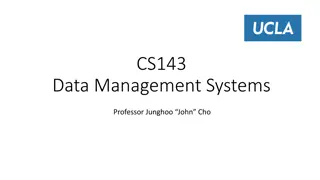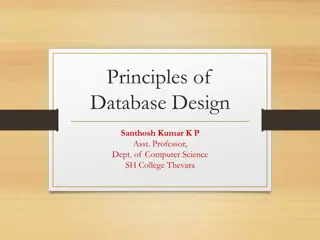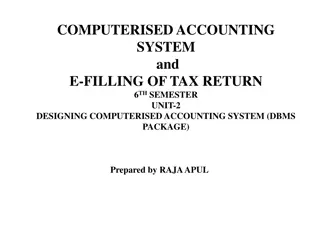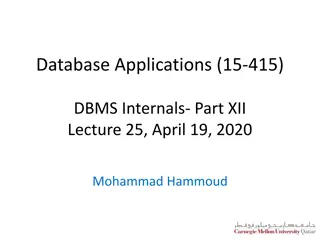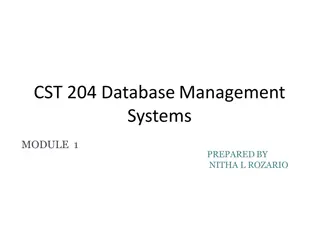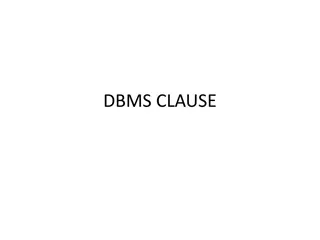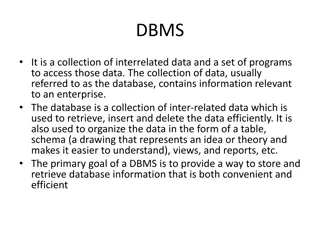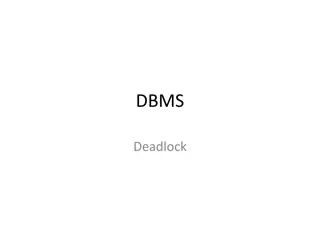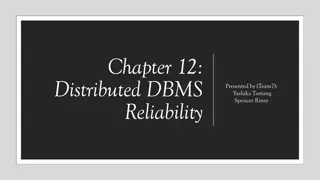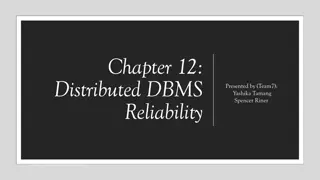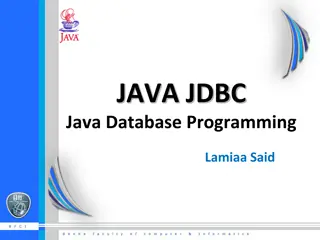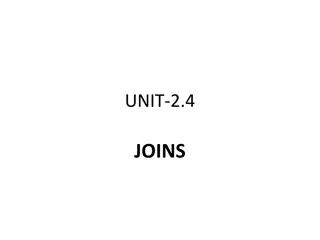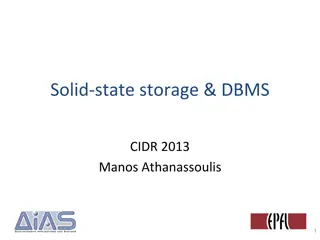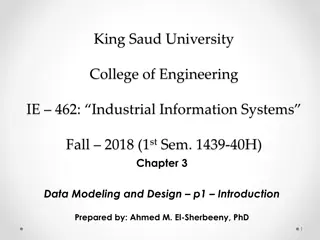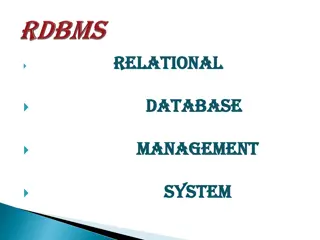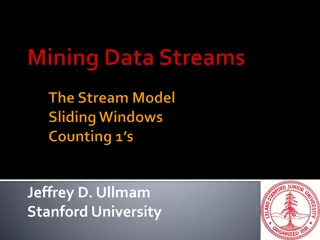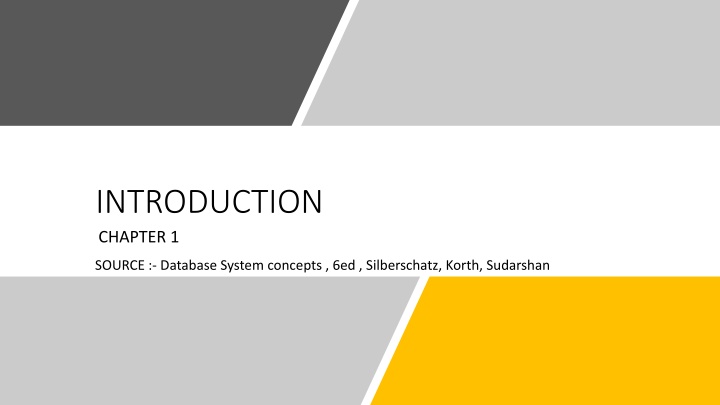
Database System Concepts and Applications
Explore the fundamentals of Database Management Systems (DBMS) through this comprehensive overview. Learn about the various applications of DBMS in different industries such as enterprise information, banking and finance, universities, airlines, and telecommunications. Understand the advantages of using a database system over traditional file processing systems, and the importance of maintaining data integrity and security.
Download Presentation

Please find below an Image/Link to download the presentation.
The content on the website is provided AS IS for your information and personal use only. It may not be sold, licensed, or shared on other websites without obtaining consent from the author. If you encounter any issues during the download, it is possible that the publisher has removed the file from their server.
You are allowed to download the files provided on this website for personal or commercial use, subject to the condition that they are used lawfully. All files are the property of their respective owners.
The content on the website is provided AS IS for your information and personal use only. It may not be sold, licensed, or shared on other websites without obtaining consent from the author.
E N D
Presentation Transcript
INTRODUCTION CHAPTER 1 SOURCE :- Database System concepts , 6ed , Silberschatz, Korth, Sudarshan
INTRODUCTION What is DBMS? A database-management system (DBMS) is a collection of interrelated data and a set of programs to access those data. The collection of data, usually referred to as the database, contains information relevant to an enterprise. The primary goal of a DBMS is to provide a way to store and retrieve database information that is both convenient and efficient Sudha Bhagavatheeswaran, Department of Information Technology, SIES College of Arts, Science & Commerce (Autonomous)
INTRODUCTION Applications Enterprise Information Sales: For customer, product, and purchase information. Accounting: For payments, receipts, account balances, assets and other accounting information. Human resources: For information about employees, salaries, payroll taxes, and benefits, and for generation of paychecks. Manufacturing: For management of the supply chain and for tracking production of items in factories, inventories of items in warehouses and stores, and orders for items. Online retailers: For sales data noted above plus online order tracking, generation of recommendation lists, and maintenance of online product evaluations Sudha Bhagavatheeswaran, Department of Information Technology, SIES College of Arts, Science & Commerce (Autonomous)
INTRODUCTION Applications Banking and Finance Banking: For customer information, accounts, loans, and banking transactions. Credit card transactions: For purchases on credit cards and generation of monthly statements. Finance: For storing information about holdings, sales, and purchases of financial instruments such as stocks and bonds; also for storing real-time market data to enable online trading by customers and automated trading by the firm. Sudha Bhagavatheeswaran, Department of Information Technology, SIES College of Arts, Science & Commerce (Autonomous)
INTRODUCTION Applications Universities: For student information, course registrations, and grades (in addition to standard enterprise information such as human resources and accounting). Airlines: For reservations and schedule information. Airlines were among the first to use databases in a geographically distributed manner. Telecommunication: For keeping records of calls made, generating monthly bills, maintaining balances on prepaid calling cards, and storing information about the communication networks. Sudha Bhagavatheeswaran, Department of Information Technology, SIES College of Arts, Science & Commerce (Autonomous)
INTRODUCTION Purpose of Database Systems File processing system :- store information in operating system files Database Systems:- Relational concept to store information Disadvantages of File Processing/ Advantages of Database Systems Data redundancy and inconsistency Difficulty in accessing data Data isolation Integrity problems Atomicity problems Concurrent-access anomalies Security problems Sudha Bhagavatheeswaran, Department of Information Technology, SIES College of Arts, Science & Commerce (Autonomous)
INTRODUCTION View of Data - Data Abstraction Physical level. The lowest level of abstraction describes how the data are actually stored Logical level. The next-higher level of abstraction describes what data are stored in the database, and what relationships exist among those data View level. The highest level of abstraction describes only part of the entire database Sudha Bhagavatheeswaran, Department of Information Technology, SIES College of Arts, Science & Commerce (Autonomous)
INTRODUCTION View of Data - Instances and Schemas The collection of information stored in the database at a particular moment is called an instance of the database. The overall design of the database is called the database schema. A database schema corresponds to the variable declarations (along with associated type definitions) in a program. Each variable has a particular value at a given instant. The values of the variables in a program at a point in time correspond to an instance of a database schema. 3 schemas The physical schema describes the database design at the physical level. The logical schema describes the database design at the logical level. A database may also have several schemas at the view level, sometimes called subschemas, that describe different views of the database. Sudha Bhagavatheeswaran, Department of Information Technology, SIES College of Arts, Science & Commerce (Autonomous)
INTRODUCTION Data Models Data model: a collection of conceptual tools for describing data, data relationships, data semantics, and consistency constraints. A data model provides a way to describe the design of a database at the physical, logical, and view levels. Relational Model. The relational model uses a collection of tables to represent both data and the relationships among those data. Each table has multiple columns, and each column has a unique name. Tables are also known as relations. Each table contains records of a particular type. Each record type defines a fixed number of fields, or attributes. The columns of the table correspond to the attributes of the record type. OFFICE CITY REGION MGR TARGET SALES 11 Mumbai Western 103 50,000 30,000 22 Pune Eastern 101 45,000 60,000 Sudha Bhagavatheeswaran, Department of Information Technology, SIES College of Arts, Science & Commerce (Autonomous)
INTRODUCTION Data Models Entity-Relationship Model (E-R) uses a collection of basic objects, called entities, and relationships among these objects. An entity is a thing or object in the real world that is distinguishable from other objects Object-Based Data Model. Java, C++, or C has led to the development of an object-oriented data model that can be seen as extending the E-R model with notions of encapsulation, methods (functions), and object identity. The object-relational data model combines features of the object-oriented data model and relational data model Sudha Bhagavatheeswaran, Department of Information Technology, SIES College of Arts, Science & Commerce (Autonomous)
INTRODUCTION Database Architecture Database Users Programs/Tools Query Processor Storage manager Disk Storage Sudha Bhagavatheeswaran, Department of Information Technology, SIES College of Arts, Science & Commerce (Autonomous)
INTRODUCTION Database Users Naive users are unsophisticated users who interact with the system by invoking one of the application programs that have been written previously. The typical user interface for naive users is a forms interface, where the user can fill in appropriate fields of the form. Naive users may also simply read reports generated from the database. Application programmers are computer professionals who write application programs. Application programmers can choose from many tools to develop user interfaces. Rapid application development (RAD) tools are tools that enable an application programmer to construct forms and reports with minimal programming effort. Sophisticated users interact with the system without writing programs. Instead, they form their requests either using a database query language or by using tools such as data analysis software. Analysts who submit queries to explore data in the database fall in this category. Specialized users are sophisticated users who write specialized database applications that do not fit into the traditional data-processing framework. Among these applications are computer-aided design systems, knowledgebase and expert systems, systems that store data with complex data types (for example, graphics data and audio data), and environment-modeling systems Sudha Bhagavatheeswaran, Department of Information Technology, SIES College of Arts, Science & Commerce (Autonomous)
INTRODUCTION Programs/Tools Application interface Application programs Query tools Administration tools Sudha Bhagavatheeswaran, Department of Information Technology, SIES College of Arts, Science & Commerce (Autonomous)
INTRODUCTION Query Processor DDL interpreter, which interprets DDL statements and records the definitions in the data dictionary. DML compiler, which translates DML statements in a query language into an evaluation plan consisting of low-level instructions that the query evaluation engine understands. The DML compiler also performs query optimization; that is, it picks the lowest cost evaluation plan from among the alternatives. Query evaluation engine, which executes low-level instructions generated by the DML compiler. Sudha Bhagavatheeswaran, Department of Information Technology, SIES College of Arts, Science & Commerce (Autonomous)
INTRODUCTION Storage Manager Authorization and integrity manager, which tests for the satisfaction of integrity constraints and checks the authority of users to access data. Transaction manager, which ensures that the database remains in a consistent (correct) state despite system failures, and that concurrent transaction executions proceed without conflicting. File manager, which manages the allocation of space on disk storage and the data structures used to represent information stored on disk. Buffer manager, which is responsible for fetching data from disk storage into main memory and deciding what data to cache in main memory. Sudha Bhagavatheeswaran, Department of Information Technology, SIES College of Arts, Science & Commerce (Autonomous)
INTRODUCTION Disk Storage Data files, which store the database itself. Data dictionary, which stores metadata about the structure of the database, in particular the schema of the database. Indices, which can provide fast access to data items. Like the index in any book, a database index provides pointers to those data items that hold a particular value. For example, we could use an index to find the instructor record with a particular ID, or all instructor records with a particular name. Sudha Bhagavatheeswaran, Department of Information Technology, SIES College of Arts, Science & Commerce (Autonomous)
INTRODUCTION Chapter 1 ends Chapter 1 ends WHAT WE COVERED .. What is DBMS? Applications Purpose of Database Systems (File Processing /Database Systems) View of Data - Data Abstraction View of Data - Instances and Schemas Data Models Database Architecture Sudha Bhagavatheeswaran, Department of Information Technology, SIES College of Arts, Science & Commerce (Autonomous)


